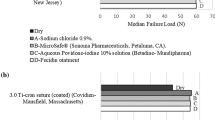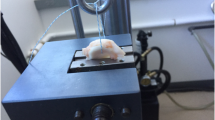Abstract
An understanding of the mechanical properties of different suture materials is valuable when selecting the most appropriate suture and repair technique. Sutures should be strong, easy to handle and have high knot security. The introduction of suture anchors adds an additional variable regarding the effect of stress risers over the eyelet. Improving the mechanical properties of a suture may be a possible method to help avoid failure over stress risers such as the eyelet of suture anchor. This study examined the static and viscoelastic properties of a new polyethylene based non-resorbable suture (Fibrewire) over the eyelet of a standard anchor compared to braid polyester non-resorbable suture (Ethibond). Fibrewire had superior ultimate load properties compared to Ethibond (360.2 N±23.8 vs 191.9 N±17.3) as well as greater stiffness (61.3 N/mm±9.7 vs 8.1 N/mm±0.4) when tested in uniaxial tension through a metal anchor eyelet (Mitek) ( p <0.001). Fibrewire demonstrated greater stress relaxation than Ethibond ( p <0.05). Differences in the static and viscoelastic properties of suture may have implications in the post-operative period or during rehabilitation.





Similar content being viewed by others
References
Barber FA, Herbert MA (1999) Suture anchors: update 1999. Arthroscopy 15:719–725
Bardana DD, Burks RT, West JR, Greis PE (2003) The effect of suture anchor design and orientation on suture abrasion: an in vitro study. Arthroscopy 19:274–281
Carpenter JE, Fish DN, Huston LJ, Goldstein SA (1993) Pull-out strength of five suture anchors. Arthroscopy 9:109–113
Chu CC (1981) Mechanical properties of suture materials: an important characterization. Ann Surg 193:365–371
Cummins CA, Strickland S, Appleyard RC, Szomor ZL, Marshall J, Murrell GA (2003) Rotator cuff repair with bioabsorbable screws: an in vivo and ex vivo investigation. Arthroscopy 19:239–248
Hecker AT, Shea M, Hayhurst JO, Myers ER, Meeks LW, Hayes WC (1993) Pull-out strength of suture anchors for rotator cuff and Bankart lesion repairs. Am J Sports Med 21:874–879
Herrmann JB (1971) Tensile strength and knot security of surgical suture materials. Am Surg 37:209–217
Meyer DC, Nyffeler RW, Fucentese SF, Gerber C (2002) Failure of suture material at suture anchor eyelets. Arthroscopy 18:1013–1019
Meyer DC, Fucentese SF, Ruffieux K, Jacob HA, Gerber C (2003) Mechanical testing of absorbable suture anchors. Arthroscopy 19:188–193
Rossouw DJ, McElroy BJ, Amis AA, Emery RJ (1997) A biomechanical evaluation of suture anchors in repair of the rotator cuff. J Bone Joint Surg Br 79:458–461
Rupp S, Georg T, Gauss C, Kohn D, Seil R (2002) Fatigue testing of suture anchors. Am J Sports Med 30:239–247
Schubert DC, Unger JB, Mukherjee D, Perrone JF (2002) Mechanical performance of knots using braided and monofilament absorbable sutures. Am J Obstet Gynecol 187:1438–1422
von Fraunhofer JA, Storey RJ, Masterson BJ (1988) Tensile properties of suture materials. Biomaterials 9:324–327
Author information
Authors and Affiliations
Corresponding author
Rights and permissions
About this article
Cite this article
Acton, D., Perry, A., Evans, R. et al. The effect of two nonresorbable suture types on the mechanical performance over a metal suture anchor eyelet. Knee Surg Sports Traumatol Arthrosc 12, 165–168 (2004). https://doi.org/10.1007/s00167-003-0399-y
Received:
Accepted:
Published:
Issue Date:
DOI: https://doi.org/10.1007/s00167-003-0399-y




